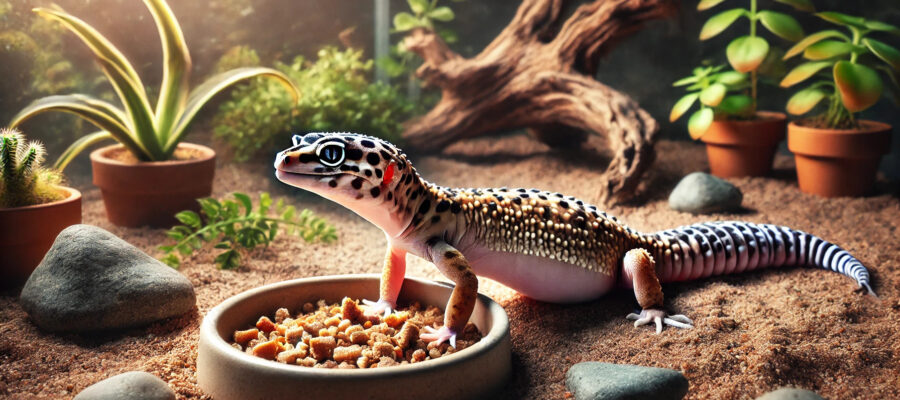Leopard geckos are hardy creatures, but ensuring they’re well-fed is key to keeping them happy and healthy. Recognizing the signs of an underfed gecko can be tricky, especially for new owners. Let’s explore how to tell if your leopard gecko isn’t getting enough food and what you can do about it.
Why Is Proper Nutrition So Important?
A well-fed leopard gecko doesn’t just look good—it thrives. Proper nutrition supports their growth, immune system, and energy levels. An underfed gecko, on the other hand, can become weak, stressed, or susceptible to illnesses.
If you’re unsure whether your feeding routine is sufficient, understanding the signs of underfeeding can make a world of difference.
Signs Your Leopard Gecko Might Be Underfed
- Visible Ribcage or Hip Bones
A healthy leopard gecko has a slightly plump body with no prominent bones visible. If you notice their ribcage, spine, or hip bones standing out, it could mean they’re not eating enough. - Thin Tail
Leopard geckos store fat in their tails, making it a good indicator of their overall health. A thin or shrinking tail suggests your gecko isn’t consuming enough calories to sustain itself. - Lethargy
Geckos are naturally active during certain times of the day, especially at dusk and dawn. If your gecko is unusually lethargic or spends excessive time hiding, they might be undernourished. - Weight Loss
Regularly monitoring your gecko’s weight is an easy way to track their health. Sudden or consistent weight loss often points to a feeding problem. A simple kitchen scale works well for keeping tabs. - Sunken Eyes
Sunken eyes can indicate dehydration, but it often accompanies underfeeding. Make sure your gecko has access to fresh water and is eating adequately.
What Causes Underfeeding in Leopard Geckos?
- Improper Feeding Schedule
Are you feeding your gecko too infrequently? Juveniles need food daily, while adults can eat every other day. - Wrong Food Size
Offering insects that are too large can deter your gecko from eating. Stick to feeder insects that are no bigger than the space between your gecko’s eyes. - Inappropriate Diet
Geckos thrive on a varied diet of gut-loaded insects like crickets, mealworms, and dubia roaches. If their diet lacks variety, they might lose interest in food. Learn more in our Feeding Guide for Leopard Geckos. - Stress or Illness
Stress from a new environment, handling, or improper enclosure setup can cause a gecko to stop eating. Similarly, underlying health issues like impaction or parasites may reduce their appetite.
How to Help an Underfed Leopard Gecko
- Reassess Their Diet
Make sure you’re offering the right types of feeder insects, like crickets and mealworms, that are gut-loaded and dusted with calcium. - Create a Feeding Schedule
Establish a routine that aligns with their age. Juveniles need more frequent meals than adults. - Check Their Environment
Ensure their enclosure has the correct temperature gradient (warm side around 90°F and cool side between 75°F and 80°F) and proper humidity. A stressed gecko won’t eat well. Learn how to set up an ideal habitat in our Housing and Setup Guide. - Consult a Vet
If you’ve adjusted their diet and environment and they’re still not eating, consult a reptile vet. Parasites or other health conditions may be at play.
Tips for Preventing Underfeeding
- Monitor Their Weight Regularly
Use a kitchen scale to track your gecko’s weight. Small fluctuations are normal, but consistent losses are a red flag. - Offer Variety
Rotate different types of insects to keep your gecko interested. Occasional treats like waxworms can be great, but don’t overdo it. - Keep a Feeding Journal
Tracking what and when you feed can help you spot patterns and adjust as needed.
Final Thoughts
Catching the signs of an underfed leopard gecko early can make all the difference. By understanding their needs, monitoring their weight, and creating a balanced feeding schedule, you can ensure your gecko stays happy and healthy.
For more feeding tips and expert advice, explore our Feeding Guides. Keep your gecko thriving with the right care and attention!
Get Your Free Leopard Gecko Care Checklist!
Are you ready to give your leopard gecko the best care possible? Download our FREE PDF e-book featuring a comprehensive care checklist!
This handy guide covers everything from habitat setup to feeding and health tips, ensuring your gecko thrives.
👉 Download your checklist now!




